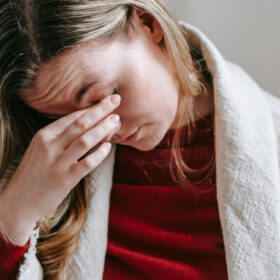
Fibroids vs endometriosis: what’s the difference?
What's the lowdown?
Fibroids and endometriosis are both fairly common gynaecological conditions affecting the female reproductive system
Both affect the uterus, however, fibroids are restricted to this area while endometriosis can extend to other areas of the body
Their symptoms can often overlap: pelvic pain, heavy bleeding, problems with fertility
Where is the pain coming from?
While fibroids and endometriosis have similar symptoms that can affect your quality of life, they are actually very distinct conditions. Taking some time to understand the differences between the two conditions will allow you to effectively express your symptoms and concerns to your doctor and work transparently with them to find an effective solution.
Here at the Lowdown, we believe in empowering our community with the knowledge to understand what is happening in their body.
The Uterus
Before we dive into fibroids vs endometriosis, let’s take some time to understand the anatomy of the uterus. Not another science lesson! Bear with us, it’ll all come together.
The uterus has 3 layers1:
- The endometrium: the lining of the uterus that sheds during our period
- The myometrium: muscle layer of the uterus
- The serosa or perimetrium: outer layer made up of epithelial cells which are skin like cells that cover most of our body’s organs
Endometriosis or Fibroids?
Fibroids are an overgrowth of the muscle layer of the uterus. There are 3 primary types of fibroids and they can affect around 70% of us2. We still do not know why they happen (like a lot of conditions), but science has found a link between fibroids and genetics! What we do know is that fibroids love oestrogen so they tend to shrink during menopause when oestrogen levels are on the decline.
Endometriosis on the other hand is a condition where cells similar to the endometrium lining of the uterus are also found in other parts of the body. It can present anywhere like the ovaries, fallopian tube, bowel and in rare cases have been discovered in the lung3! It affects 10% of women in the UK4.
So with 70% of us having fibroids and 10% of us having endometriosis, it’s clear there will be some people who have both.
What’s the difference between fibroid and endometriosis symptoms?
So now we know the difference between the two conditions, let’s dive into how these conditions present themselves. Some individuals might not experience any symptoms while living with the condition and can go years without getting a diagnosis, others may be able to tell which symptom is being caused by which condition.
Fibroid symptoms
The common symptoms of fibroids are:
- Heavy periods (menorrhagia)
- Bleeding between periods (intermenstrual bleeding)
- Tiredness due to iron deficiency anaemia
- Increased need to pee
- Pain in the back or pelvic region
- Constipation and bloating
- Discomfort during sex
- Difficulty getting pregnant
Endometriosis symptoms
The common symptoms of endometriosis are:
- Heavy periods (menorrhagia)
- Painful periods (dysmenorrhea)
- Bleeding between periods (intermenstrual bleeding)
- Painful during urination or bowel movements
- Pain in the back or pelvic region
- Bloating
- Painful sexual intercourse
- Fatigue
- Difficulty getting pregnancy
As you can see there is a large overlap in symptoms and it can be confusing to know what is the underlying reason without getting medical advice. If you want some answers to your symptoms and are tired of waiting for an appointment, we have a team of women’s health GPs who are here to listen and support you in understanding your body. That is why the Lowdown was created!
Fibroids or endometriosis
If the symptoms are so similar, how will you know what’s actually wrong? Fibroids can be diagnosed on a pelvic exam and can be easily confirmed with an ultrasound scan5. However, endometriosis is a little tricker. The best investigation is a laparoscopy (a small camera inserted into your abdomen to look for endometrial tissue outside the uterus)6. Sadly, ultrasound and MRI scans are often not sensitive enough to pick up every detail of these foreign endometrial tissues. These scans can give a diagnosis for some women, but if they’re normal, it doesn’t mean you definitely do not have endometriosis. However, you can start treatment for suspected endometriosis based on your symptoms alone if you are not keen on surgery.
Treatment
The treatment for both endometriosis and fibroids is not straightforward, there are a lot of considerations to take into account. Generally for heavy periods, oral medication can be offered to reduce your blood flow. Varying strengths of painkillers can tackle painful periods and hormonal contraception can be used to both reduce or stop period flow and minimise painful periods. We have dedicated blogs just navigating the world of both fibroid and endometriosis treatment options!
Endometriosis with fibroids
There is no reason why the conditions cannot occur in tandem as they originate from different parts of the body and pelvis and we think have different causes (but we still don’t know exactly what causes either). Some research has shown that endometriosis does present with fibroids and vice versa7 as both these conditions have links to oestrogen.
Summary
It is clear that the cause of endometriosis and fibroids are distinct but the way they present themselves with symptoms have an overlap.
We have a community of people with endometriosis who have had their battles and now want to spread awareness of the condition. They have opened up about their personal experiences so you can learn from the struggles that resonate with you! And if you feel your experience will benefit someone else in their endometriosis journey, speak up as you never know how it might support others!
Our medical review process
This article has been medically reviewed for factual and up to date information by a Lowdown doctor.






